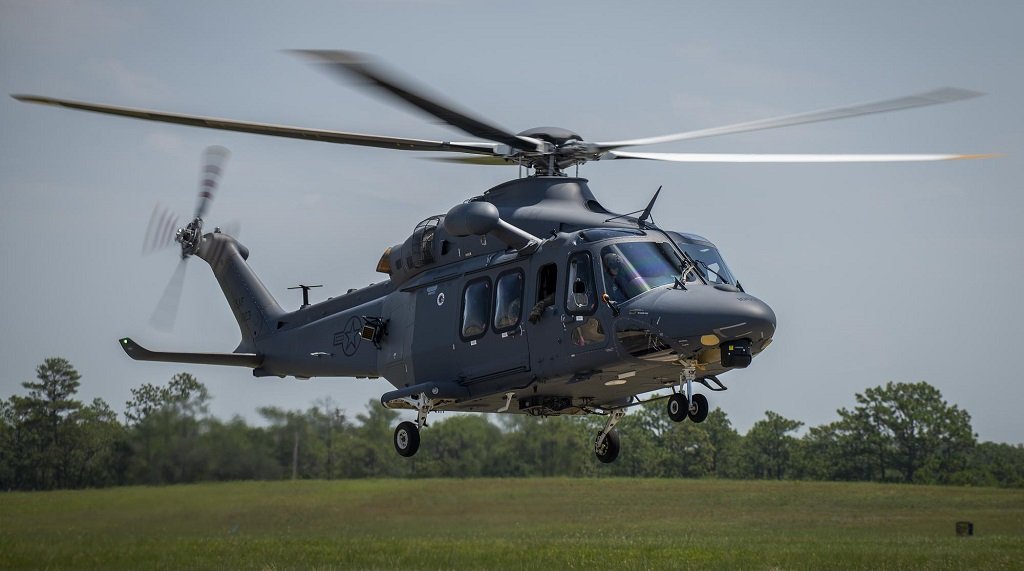[ad_1]

The helicopter has finally received the FAA Certification and Military Flight Release to proceed with the next phases of the development.
The U.S. Air Force announced that the MH-139 Grey Wolf is now entering the developmental testing phase after it received both the FAA Certification and the Military Flight Release. In mid-August, few weeks after Boeing completed the final FAA Supplemental Type Certification required for the MH-139A to achieve its Military Flight Release, four helicopters were delivered and accepted by the Air Force to begin testing.
“Leonardo’s 139 helicopter has an impressive pedigree of performance in multiple missions in the civil, public, and military domains,” said Lt. Col. Josh Hallford, Chief, MH-139 Standardization and Evaluations MH-139 Test Detachment 7. “The built-in system redundancies and physical performance of the aircraft show great potential for improving on the myriad of missions that have been covered by the venerable Huey for so long. We’re excited to get it into test and find out what it can really do.”
The MH-139 experienced unexpected delays because of the integration of two defensive systems, an airspeed sensor and the FAA certification. While the commercial AW-139 is already certified by the FAA, the MH-139 conversion needs FAA-approved Supplemental Type Certifications (STCs) for military-specific equipment. More specifically, the MH-139 requires three STCs after Boeing installs the military equipment on the Leonardo-supplied airframe.
The defensive systems installed on the MH-139 which caused some of the delays are the ALE-47 Airborne Countermeasures Dispenser System and the AAR-47 Missile Warning System. Last year, the Air Force said that the fairing that connects the ALE-47 and the AAR-47 to the MH-139 airframe caused some airflow anomalies, but Boeing redesigned is and it was validated after testing. This, in turn, also delayed the release of the STCs for these components.
A fairing was the problem that caused the delay related to the airspeed sensor last year. During the joint USAF-Boeing flight tests, pilots discovered inaccurate readings by one of the airspeed sensors while performing certain maneuvers. The solution required redesigning the sensor’s fairing because it affected the air flow hitting the pitot tubes, leaving the pilots with incorrect air speed readings.

These technical problems delayed the FAA certification of the Grey Wolf, but they weren’t the only issues. Boeing’s head of Vertical Lift Mark Cherry said the process took longer than expected also because the FAA had no experience evaluating some of the aircraft’s military equipment, such as its identification friend-or-foe (IFF).
The delays resulted in the delay of the acquisition of eight helicopters financed in the FY2021 budget and the cancellation of the acquisition of eight MH-139s from the FY2022 budget, pushing back the production of the helicopter. Now, with the delivery of the four helicopters, the Air Force will conduct testing of critical military capabilities of the MH-139A as the program progresses towards Milestone C, the start of the production.
“We are thrilled that the first four MH-139As have been accepted by the U.S. Air Force” said Clyde Woltman, Chief Executive Officer, Leonardo Helicopters U.S. “This aircraft is well-positioned to become an important asset in the defense and security of the United States.” Leonardo will produce the helicopter at its FAA-certified Part 21 facility in northeast Philadelphia, while Boeing is responsible for military equipment procurement and installation, and post-delivery support of the aircraft.
Prior to ownership, the aircraft went through rigorous acceptance test conducted by Air Force Global Strike Command Detachment 7 and 413th Flight Test Squadron pilots. In the meanwhile, on August 17, the Air Force conducted its first all-USAF crew flight with the MH-139 from Duke Field, few days after receiving the military flight release. The aircraft’s first flight was performed under its new radio call sign, Lycan, meaning werewolf.
The goal for the next 15 months of testing on the four MH-139As here will be to validate the safety of the aircraft and define the limits and maneuvers that can be performed. The developmental testing at Duke Field will make sure the MH-139A meets AFGSC requirements for operational missions and define baseline operational capabilities upon which to build tactics, techniques, and procedures.
The Air Force is planning to buy 80 MH-139 Grey Wolf helicopters, just shy of the initial plan for 84 helicopters, to replace the ageing fleet of 63 UH-1N Huey helicopters. “The Grey Wolf is a modern, versatile aircraft offering greater range, speed and endurance than the UH-1N Huey it replaces,” said Cherry.
The helicopters will provide vertical airlift and support to four Air Force Major Commands and other operating agencies including Air Force Global Strike Command, Air Education and Training Command, Air Force Materiel Command, Air Force Reserve Command, and the Air Force District of Washington (AFDW). One of their most notable roles is the protection of the intercontinental ballistic missile (ICBM) facilities and, in fact, Air Force Global Strike Command is the lead command and operational capability requirements sponsor for the MH-139.
Joint Base Andrews, Maryland, was recently selected as the fourth location to receive the Grey Wolf, after Malmstrom Air Force Base, Montana, Minot Air Force Base, North Dakota, and F.E. Warren Air Force Base, Wyoming. Maxwell Air Force Base, Alabama, will be hosting the MH-139’s Formal Training Unit.
[ad_2]
Source link
